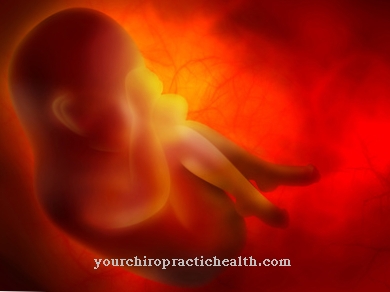Over 1800 children are born in Germany every day. In a hospital alone there are 10 to 12 every day, i.e. 300 a month and around 3600 a year. A quite impressive number, which at the same time reveals an abundance of work by midwives and gynecologists. But no matter how many births we experience daily in our hospitals, we are often impressed by the babies' first cry, whose delicate little fingers and legs vigorously thrust into the air as if they wanted to beat the beat to "their music".
Birth preparation

This is one of the most beautiful moments, and a feeling of satisfaction grips us when we see the radiant, happy smile of the mother who has just been given her little one infant puts in her arms.
The anxious hours before the are forgotten birth, forgotten is the pain. This observation often puzzles you. I don't want to get into your head how you could almost instantly forget such enormous pain - many young mothers roll over screaming, in the delivery bed, without even listening to the midwife's words. Enlightenment can then be found in those women with whom you can find the birth could hear less and who at first seemed very brave. But it was soon realized that bravery is not the one birth almost painless, but rather conscious action and good preparation.
Those women weren't afraid of hers Childbirth; they were relaxed and therefore painless. This fact may sound astonishing to some, but everyone knows it themselves who has, for example, been given an injection. If I tense my muscles - because I'm afraid of the injection - the puncture really hurts me. But if the patient is not afraid of the syringe, he has no reason to cramp and the puncture will not hurt either. Understanding education, patience and a trusting relationship between doctor and patient are of course the necessary prerequisites.
It's the same with one Pregnant women. During the monthly consultations at the counseling center, she should get to know her doctor and gain confidence in him. During this time, she should learn and practice gymnastics, relaxation and breathing exercises that she does birth Take away fear and pain. Pregnancy counseling is therefore a part of the Birth preparation by a doctor and midwife. But also the knowledge of the Birthing process itself belongs to the preparation, especially for the possible freedom from pain. However, the pregnant woman has to work out this herself, and we want to help her with this guide.
Due date
A normal one birth occurs when the fruit has reached the level of ripeness that enables life outside the womb. In general, this is the case if the child weighs about 3,000 grams, is 49 to 52 centimeters tall, protrudes over the nails, fingers and toes, and the hair on the forehead is cut sharply. The skin is pale pink, in boys the testicles have entered the scrotum, and in girls the large labia close the pubic area. The ripe infant immediately screams in a loud voice, moves vigorously and can also suck vigorously.
However, this maturity is not reached on a certain day, but has existed for days, sometimes even weeks, without it therefore already to birth comes. This fact makes it impossible for the doctor to determine the exact Due date to determine. So far it is not yet known exactly which factors ultimately determine the onset of labor. It is believed that hormonal changes as well as shifts in the body's salt balance are involved. But the size of the child certainly plays a role for him Onset of birth.
Onset of birth
Towards the end of the pregnancy the pregnant woman notices a significant sagging of the body. The belt of her dress has widened a little, the pressure on the stomach and heart has eased, and breathing becomes freer and easier again. This lowering of the abdomen is often associated with minor contractions. Many women already believe they are getting it infant. They come to the clinic excited, nervous and completely rushed. There you will then find out that which contractions are completely normal and that they still have about four weeks to go birth Have time.
The real one birth begins only when contractions occur regularly, every 10 minutes - at least an hour in a row. Now the pregnant woman has to go to the clinic. A woman who is expecting her first child has a little longer time than a mother who has already given birth. The whole Length of birth is 13 to 20 hours for a primiparous woman, 7 to 12 hours for multiparous women.
Opening period
The birth runs in three important sections that every woman giving birth should be familiar with. We call the first and longest period the opening period. It takes 2 to 19 hours for primiparous women and 11 hours for multiparous women and is used to completely open the lower section of the uterus, the cervix, from the inside to the outside. Without the opening of the inner and outer cervix, the child cannot get out of the uterus. This work of opening represents a great achievement of the body, because the cervix expands to a diameter of 10 to 12 cm.
If the cervix is open, the bladder bursts in forty percent of all pregnant women. The amniotic fluid in which the fruit is used birth floats to be protected from shocks and injuries, deflates. However, the amniotic sac often ruptures later without causing any significant danger to the child. However, if the amniotic sac should jump and empty the amniotic fluid before labor begins, the pregnant woman must lie down be transported to the hospital, otherwise there is a very easy risk of infection.
Expulsion period
After the cervix is opened, the second begins Part of labor, the so-called expulsion period, which lasts 3/4 to 1 1/2 hours in the first-time woman and 1/4 to 1 hour in the multiparous woman. Now the child is born. Most of the time, the head comes through the pelvic canal first, followed by rotating movements - just as with the head passage - the shoulders and finally the trunk.
In this section, the pregnant woman herself must help out. Shortly after the start of a contraction, she has to press hard. Now it becomes clear whether she can correctly apply the exercises previously learned in the gymnastics course. If she succeeds, then she will belong to those women with whom - as already mentioned at the beginning - less can be heard than can be observed.
The expulsion period in which the child is born puts extreme stress on the soft parts of the abdomen such as the vagina, pelvic floor muscles and perineum. The fully opened cervix can no longer oppose the forces acting on the uterus from all sides (diaphragm and abdominal pressure, increased contraction of the uterine muscle), which push the child out like a roller.
With the help of certain rotary movements, this "fruit roller" overcomes the pelvic canal and stretches the vagina and vaginal outlet as much as possible. The hard, preceding part, the head, paves the way for the following body. At the moment when the head emerges from the mother's body, the pregnant woman must under no circumstances press along with it, otherwise the force of the emergent head can tear the perineum.
Even now, the mother must still follow the instructions of the midwife or doctor. In some cases, doctors are forced to make a preventive incision in order to prevent a rupture of the perineum, which arises voluntarily, which is then sutured again under anesthesia after the birth.
Postpartum period
Once the child has given the first cry, the umbilical cord is pinched off and cut. The third and last section of the birth, the Postpartum period. Around 10 to 15 minutes after the birth the placenta, the placenta, is expelled. The puerperium now begins, during which the uterus returns to its normal size, which takes 6 to 8 weeks. During this time, first bloody, then more watery discharge is constantly secreted. The uterus, which weighs 1 kilogram after birth, has returned to its normal weight of around 50 grams after this time. The regression of the abdominal wall is understandably very important to women. But here too the young mother has to actively help out again. She can start exercising on the first day of delivery. Read about slim after childbirth and pregnancy.
Finally, a note to those women who assume that everything comes and goes by itself. As for many things, it also applies to pregnancy and birth not at all. It also requires conscious participation and active cooperation - whether before, during or after the birth.

























.jpg)

.jpg)
